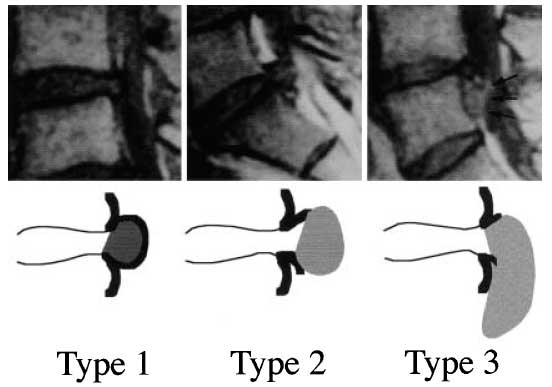Komori H, "Factors predicting the prognosis of lumbar radiculopathy due to disc herniation" J Orthop Sci - 2002; 7:56-61.
The only interesting thing to come from this poorly written outcome study was the suggestion that the type of disc herniation (i.e., bulge, protrusion, or extrusion) may be predictive of a patient's final clinical outcome and level of impairment.
More explicitly, it was demonstrated the "contained disc herniation" (aka: subligamentous disc herniations) responded poorly to disc surgery. The forgoing conclusion was also demonstrated in other investigations included one from Volvo Award winner, Eugene Carragee of Sanford Medical University.
Unfortunately, the methodology of this investigation was error filled. First of all they did not tell us the ratios of Type 1, 2, and 3 herniations, for the conservative patients. Next, the Questionnaires distribution did NOT match a specific recover period on a patient by patient basis, which is the norm. Instead they mailed all questionnaires out the same day, which has lead to some patients having a two year longer recovery period than others! What idiots! And finally, I had to throw out the entire "second follow-up" for there was only a 69% patient's response rate: which is not statistically enough to predict an outcome. (Komori should have known this.) The first assessment had an 85% patient participation (90 patients) which is enough to predict an outcome.
The Japanese study that initially consisted of 245 sciatica-suffering patients was highly selective as it excluded conditions such as spondylolisthesis, spondylosis, and both central and contralateral disc herniation. Of the remaining 131 qualifying patients, who were referred from local hospitals, 100% of them suffered severe disc-herniation induced sciatica, which was so severe in 14 cases that over-night hospitalization was required.
They were all treated conservatively initially. This consisted of traction, rest, drugs, at an outpatient clinic (except for the 14 who received it in the hospital.)
After two months, the severely symptomatic patients, or the ones who demonstrated: severe neurological deficit (foot-drop), and/or severe persistent leg pain for a one month period; were taken in for surgery. The ones who did not meet the criteria for surgery were given continued conservative care. (Some of the ones who met the surgical requirements refused the surgery.) 50 patients were sent to the surgery group (because of intolerable leg pain) and 81 into the conservative group. Amazingly, only 25 patients (50%) of the surgical group chose surgery, the others chose to continue with conservative care so the grand total of the conservative group was 106 patients (25 of who were bad enough for surgery). (On ones with more severe leg pain was the ones who had surgery). The surgical technique was not described!
The conservative group was assessed via two questionnaires; one on April of 1994, and the other on April of 1996. This was a rather strange way to do things because it did not compare the patients to an equal recovery time scale, since the patient induction period was roughly over a two year time-span. This means that at the first questionnaire some of the patients had recovered for almost 3 years while others for only 1 year.
Outcome Scale :
The patients were asked to assess their own conditions based on these three scales:
Poor: No change of residual symptoms - disabled in the activities of daily living (ADL).
Fair: Residual symptoms - residual symptoms - not disabled in the ADL.
Good: greatly reduced pain or non at all.
Disc Herniation Types:
Herniation types were assessed, although they never gave the statistics of how many patients had type 1, type 2, or type 3 - a significant error. See figure #1.

First Follow-up: 1 to 3 year outcome (90 patients)
Patients lost to Surgery:
6%
No leg pain at 1 to 3 years:
50%
Moderate to severe leg pain:
21%
Self rating of 'chick out' of surgery group:
50% Poor
Type of Disc Herniation versus conservative group outcome:
Good self-rating for Sequestration group:
66%
Good self-rating for Extrusion group:
56%
Good self-rating for Subligamentous group:
18%
Poor self-rating for Sequestration group:
15%
Poor self-rating for Extrusion group:
11%
Poor self-rating for Subligamentous group:
43%
Assessment #2: (3 to 5 years)
Thrown out: 69% patient response rate.
Conclusion:
What a waste! This could have been such a good study! I will never buy another article from the "Journal of Orthopaedic Science " ( yes, that how they spelled Orthopedic)
This study, as have others, does show that 'contained disc herniations' seem to carry a worse prognosis than the more serious disc extrusions, and sequestrations! The conundrum of the disc herniation!